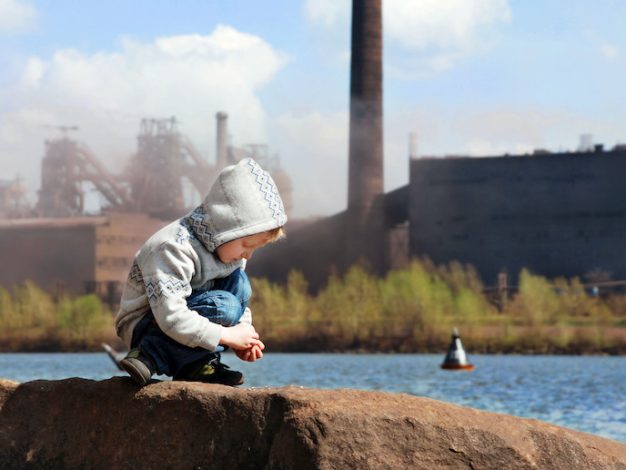
Combined effects of air pollution and heat exposure in Europe: time for action
Our health and well-being are significantly impacted by our local environment, and we are exposed to many different sources of environmental risks (e.g. various forms of pollution) in our daily lives.
Measures such as reducing air and noise pollution and providing access to high quality green spaces are shown to have a positive influence on health, reducing the occurrence of pollution related illnesses and deaths and improving people’s quality of life. Two of the more significant environmental stressors on our health are exposure to air pollution and exposure to extreme temperatures.
Premature deaths in EU-27 related to fine particulate (PM2.5) air pollution amount to well over 200,000 every year. Whilst this is a significant reduction on the attributable deaths of 20 years ago, this number is still too high. This impact is also more likely to be on vulnerable groups, in particular the elderly and children as well as those of lower socio-economic status (EEA, 2018). Cities in particular are heavily exposed to air pollution with nearly all citizens in cities exposed to pollution above the guideline values from the World Health Organization.
Cities have also been demonstrated to be particularly susceptible to increasing temperatures related to climate change. Due to factors such as the urban heat island effect, cities can be significantly warmer than the surrounding areas. Extreme heat events in the summer of 2022 have resulted in more than 60,000 estimated deaths in Europe (Ballester et al., 2023).
This is a growing concern as the number of days with extreme temperatures is expected to increase as a result of climate change. Under climate projections, by the end of the 21st century we can expect 60 days with heatwave conditions dangerous to health in parts of Southern Europe. These projections, combined with the increasing vulnerability of the population due to ageing, prevalence of chronic diseases and urbanisation, may increase the number of heatwave-related deaths in the future, unless adaptive actions are taken (EEA, 2022).
Historically, the impacts of environmental factors such as noise, air pollution and heat tended to be assessed in isolation. However, in practice, people are likely to be exposed to multiple different risk factors at the same time and these can act in combination to impact on health. This is particularly the case for air pollution and heat stress, where there is growing evidence that exposure to both at the same time presents a greater combined risk to health than the sum of their individual risks. For example, research on this topic has identified that the risk of mortality related to respiratory disease for the air pollutants PM2.5 and ozone is increased with the addition of high temperatures (Tracey Areal et al., 2022).
Another recent study identified that the increased mortality risk related to exposure to extreme heat was 6.1 per cent and for elevated PM2.5 was 5.0 per cent, however the mortality risk for combined exposure to both extreme heat and PM2.5 was estimated at 21 per cent, i.e. significantly greater than the risk for exposure to either factor on its own (Rahman et al., 2022). In fact, available evidence indicates increased mortality risk for combined exposure to heat and elevated concentrations of any of the three key air pollutants, PM2.5, ozone or nitrogen dioxide (EEA, 2020).
In addition to substantially increasing the temperatures in Europe, climate change is projected to impact the emissions of air pollutants (e.g. through more and larger wildfires) and their formation in the atmosphere (e.g. ground level ozone) (European Climate and Health Observatory, 2022).
Reducing risk through zero pollution and climate adaptation measures
Given the projections for more frequent episodes of extreme summer temperatures in Europe, what can we do to reduce the combined risk from exposure to air pollution and heat?
The people most at risk include vulnerable groups such as the elderly and those living with existing illnesses (e.g. respiratory disease and heart disease). Reducing air pollution will reduce the pollution-related occurrences of these diseases and improve the underlying health of the population. This increases the resilience of the population in coping with the impacts of extreme heat.
Analysis of potential future climate change scenarios has demonstrated that reducing air pollution will result in fewer climate change driven deaths (Fann et al., 2021), re-iterating the need to continue reducing pollution until the effects are no longer significant, in line with the objectives of the EU Zero Pollution Action Plan. Key sources of air pollution include transport, domestic heating, agriculture, energy generation and industry. By reducing emissions in these sectors we can further reduce pollution levels in our cities.

A range of measures can also be introduced to decrease the impact of heat on our health, some of which can reduce exposure to air pollution at the same time (EEA, 2022):
- Development of heat health action plans and early warning systems to ensure appropriate measures are taken in advance of and during heat waves. These can be at both a national and local level, with one of the key objectives being to raise awareness within the population, particularly in vulnerable groups, as well as establishing procedures for the healthcare and social care services to reduce the heat impacts.
- Taking appropriate measures in the urban planning of our cities, for example increasing urban green space and ensuring green surroundings of schools and hospitals to reduce the urban heat island effect in these locations. A greener environment also tends to encourage walking and cycling, thus resulting in reduced transport emissions.
- Upgrading and adapting the built environment to improve its energy efficiency and reduce indoor temperatures (e.g. renovations to include solar blinds or reflective roofs and facades). Mechanical ventilation, increasingly adopted in energy-efficient homes, may also improve the indoor air quality due to use of filters.
- Putting in place measures to protect workers, such as adjusting working hours for outdoor workers to avoid working in the hottest parts of the day.
What next: identify and implement integrated solutions
The health and well-being of Europeans are being impacted by multiple different environmental risk factors in combination, related to the threat from issues such as climate change, pollution and biodiversity loss. In order to effectively tackle these risks, it is crucial to identify and implement integrated solutions, which can address these risk factors in unison through a multi-sectoral approach (Viegas, 2022).
Preventative measures aimed at boosting the general health of the population; reduction of air pollutant and greenhouse gases emissions from all sources; urban planning prioritising active mobility and public transport and access to green spaces; building improvements; and a society that is more aware of these risks are examples of win-win measures.
This article was first published by the European Environment Agency and is republished here under Creative Commons Licensing guidelines. The EEA is an official agency of the European Union that delivers knowledge and data to support Europe’s environment and climate goals.




